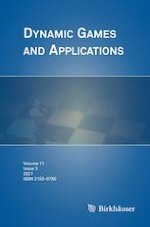17-02-2021
A Mean Field Approach for Discounted Zero-Sum Games in a Class of Systems of Interacting Objects
Published in: Dynamic Games and Applications | Issue 3/2021
Log inActivate our intelligent search to find suitable subject content or patents.
Select sections of text to find matching patents with Artificial Intelligence. powered by
Select sections of text to find additional relevant content using AI-assisted search. powered by
